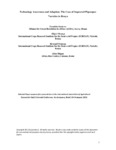Technology Awareness and Adoption: The Case of Improved Pigeonpea Varieties in Kenya
| dc.contributor.author | Simtowe, Franklin | |
| dc.contributor.author | Munyua, Bernard | |
| dc.contributor.author | Diagne, Aliou | |
| dc.date.accessioned | 2019-08-02T06:35:11Z | |
| dc.date.available | 2019-08-02T06:35:11Z | |
| dc.date.issued | 2012 | |
| dc.identifier.uri | http://ir.mksu.ac.ke/handle/123456780/4692 | |
| dc.description.abstract | We apply a program evaluation technique to data obtained from rural Kenya to assess the patterns of adoption of improved pigeonpea varieties. The sample adoption rate of improved pigeonpea is found to be 36% while potential adoption rate is estimated at 48%. The adoption gap resulting from the incomplete exposure to the improved pigeonpea is 12%. Adoption is prominent among farmers that close to the agricultural offices, and among younger and wealthier farmers. The findings suggest that there is scope for increasing pigeonpea adoption once the farmers are exposed to the new technologies and once the associated constraints are addressed. | en_US |
| dc.language.iso | en_US | en_US |
| dc.subject | Pigeonpea | en_US |
| dc.subject | Adoption | en_US |
| dc.subject | Average Treatment Effect | en_US |
| dc.subject | Kenya | en_US |
| dc.title | Technology Awareness and Adoption: The Case of Improved Pigeonpea Varieties in Kenya | en_US |
| dc.type | Article | en_US |
Files in this item
This item appears in the following Collection(s)
-
School of Agricultural Sciences [118]
Sholary Articles by Faculty & Students in School of Agricultural Sciences

